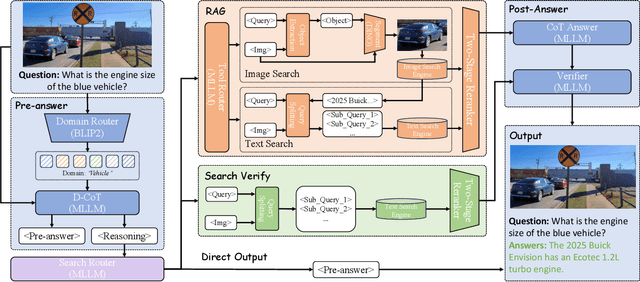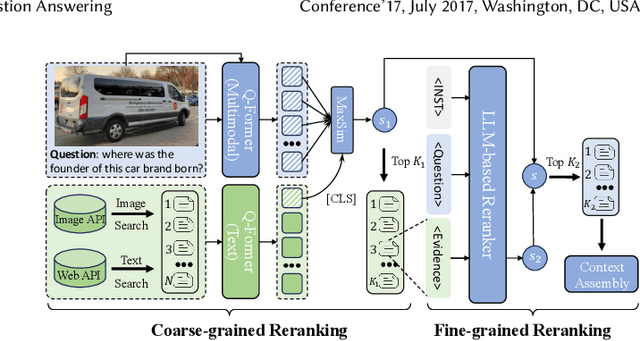Qing Li
Peng Cheng Laboratory
Explicit and Implicit Data Augmentation for Social Event Detection
Sep 04, 2025Abstract:Social event detection involves identifying and categorizing important events from social media, which relies on labeled data, but annotation is costly and labor-intensive. To address this problem, we propose Augmentation framework for Social Event Detection (SED-Aug), a plug-and-play dual augmentation framework, which combines explicit text-based and implicit feature-space augmentation to enhance data diversity and model robustness. The explicit augmentation utilizes large language models to enhance textual information through five diverse generation strategies. For implicit augmentation, we design five novel perturbation techniques that operate in the feature space on structural fused embeddings. These perturbations are crafted to keep the semantic and relational properties of the embeddings and make them more diverse. Specifically, SED-Aug outperforms the best baseline model by approximately 17.67% on the Twitter2012 dataset and by about 15.57% on the Twitter2018 dataset in terms of the average F1 score. The code is available at GitHub: https://github.com/congboma/SED-Aug.
LimiX: Unleashing Structured-Data Modeling Capability for Generalist Intelligence
Sep 03, 2025Abstract:We argue that progress toward general intelligence requires complementary foundation models grounded in language, the physical world, and structured data. This report presents LimiX, the first installment of our large structured-data models (LDMs). LimiX treats structured data as a joint distribution over variables and missingness, thus capable of addressing a wide range of tabular tasks through query-based conditional prediction via a single model. LimiX is pretrained using masked joint-distribution modeling with an episodic, context-conditional objective, where the model predicts for query subsets conditioned on dataset-specific contexts, supporting rapid, training-free adaptation at inference. We evaluate LimiX across 10 large structured-data benchmarks with broad regimes of sample size, feature dimensionality, class number, categorical-to-numerical feature ratio, missingness, and sample-to-feature ratios. With a single model and a unified interface, LimiX consistently surpasses strong baselines including gradient-boosting trees, deep tabular networks, recent tabular foundation models, and automated ensembles, as shown in Figure 1 and Figure 2. The superiority holds across a wide range of tasks, such as classification, regression, missing value imputation, and data generation, often by substantial margins, while avoiding task-specific architectures or bespoke training per task. All LimiX models are publicly accessible under Apache 2.0.
FlowletFormer: Network Behavioral Semantic Aware Pre-training Model for Traffic Classification
Aug 27, 2025Abstract:Network traffic classification using pre-training models has shown promising results, but existing methods struggle to capture packet structural characteristics, flow-level behaviors, hierarchical protocol semantics, and inter-packet contextual relationships. To address these challenges, we propose FlowletFormer, a BERT-based pre-training model specifically designed for network traffic analysis. FlowletFormer introduces a Coherent Behavior-Aware Traffic Representation Model for segmenting traffic into semantically meaningful units, a Protocol Stack Alignment-Based Embedding Layer to capture multilayer protocol semantics, and Field-Specific and Context-Aware Pretraining Tasks to enhance both inter-packet and inter-flow learning. Experimental results demonstrate that FlowletFormer significantly outperforms existing methods in the effectiveness of traffic representation, classification accuracy, and few-shot learning capability. Moreover, by effectively integrating domain-specific network knowledge, FlowletFormer shows better comprehension of the principles of network transmission (e.g., stateful connections of TCP), providing a more robust and trustworthy framework for traffic analysis.
Rethinking Domain-Specific LLM Benchmark Construction: A Comprehensiveness-Compactness Approach
Aug 13, 2025Abstract:Numerous benchmarks have been built to evaluate the domain-specific abilities of large language models (LLMs), highlighting the need for effective and efficient benchmark construction. Existing domain-specific benchmarks primarily focus on the scaling law, relying on massive corpora for supervised fine-tuning or generating extensive question sets for broad coverage. However, the impact of corpus and question-answer (QA) set design on the precision and recall of domain-specific LLMs remains unexplored. In this paper, we address this gap and demonstrate that the scaling law is not always the optimal principle for benchmark construction in specific domains. Instead, we propose Comp-Comp, an iterative benchmarking framework based on a comprehensiveness-compactness principle. Here, comprehensiveness ensures semantic recall of the domain, while compactness enhances precision, guiding both corpus and QA set construction. To validate our framework, we conducted a case study in a well-renowned university, resulting in the creation of XUBench, a large-scale and comprehensive closed-domain benchmark. Although we use the academic domain as the case in this work, our Comp-Comp framework is designed to be extensible beyond academia, providing valuable insights for benchmark construction across various domains.
Mol-R1: Towards Explicit Long-CoT Reasoning in Molecule Discovery
Aug 11, 2025Abstract:Large language models (LLMs), especially Explicit Long Chain-of-Thought (CoT) reasoning models like DeepSeek-R1 and QWQ, have demonstrated powerful reasoning capabilities, achieving impressive performance in commonsense reasoning and mathematical inference. Despite their effectiveness, Long-CoT reasoning models are often criticized for their limited ability and low efficiency in knowledge-intensive domains such as molecule discovery. Success in this field requires a precise understanding of domain knowledge, including molecular structures and chemical principles, which is challenging due to the inherent complexity of molecular data and the scarcity of high-quality expert annotations. To bridge this gap, we introduce Mol-R1, a novel framework designed to improve explainability and reasoning performance of R1-like Explicit Long-CoT reasoning LLMs in text-based molecule generation. Our approach begins with a high-quality reasoning dataset curated through Prior Regulation via In-context Distillation (PRID), a dedicated distillation strategy to effectively generate paired reasoning traces guided by prior regulations. Building upon this, we introduce MoIA, Molecular Iterative Adaptation, a sophisticated training strategy that iteratively combines Supervised Fine-tuning (SFT) with Reinforced Policy Optimization (RPO), tailored to boost the reasoning performance of R1-like reasoning models for molecule discovery. Finally, we examine the performance of Mol-R1 in the text-based molecule reasoning generation task, showing superior performance against existing baselines.
LoSemB: Logic-Guided Semantic Bridging for Inductive Tool Retrieval
Aug 11, 2025Abstract:Tool learning has emerged as a promising paradigm for large language models (LLMs) to solve many real-world tasks. Nonetheless, with the tool repository rapidly expanding, it is impractical to contain all tools within the limited input length of LLMs. To alleviate these issues, researchers have explored incorporating a tool retrieval module to select the most relevant tools or represent tools as unique tokens within LLM parameters. However, most state-of-the-art methods are under transductive settings, assuming all tools have been observed during training. Such a setting deviates from reality as the real-world tool repository is evolving and incorporates new tools frequently. When dealing with these unseen tools, which refer to tools not encountered during the training phase, these methods are limited by two key issues, including the large distribution shift and the vulnerability of similarity-based retrieval. To this end, inspired by human cognitive processes of mastering unseen tools through discovering and applying the logical information from prior experience, we introduce a novel Logic-Guided Semantic Bridging framework for inductive tool retrieval, namely, LoSemB, which aims to mine and transfer latent logical information for inductive tool retrieval without costly retraining. Specifically, LoSemB contains a logic-based embedding alignment module to mitigate distribution shifts and implements a relational augmented retrieval mechanism to reduce the vulnerability of similarity-based retrieval. Extensive experiments demonstrate that LoSemB achieves advanced performance in inductive settings while maintaining desirable effectiveness in the transductive setting.
QA-Dragon: Query-Aware Dynamic RAG System for Knowledge-Intensive Visual Question Answering
Aug 07, 2025



Abstract:Retrieval-Augmented Generation (RAG) has been introduced to mitigate hallucinations in Multimodal Large Language Models (MLLMs) by incorporating external knowledge into the generation process, and it has become a widely adopted approach for knowledge-intensive Visual Question Answering (VQA). However, existing RAG methods typically retrieve from either text or images in isolation, limiting their ability to address complex queries that require multi-hop reasoning or up-to-date factual knowledge. To address this limitation, we propose QA-Dragon, a Query-Aware Dynamic RAG System for Knowledge-Intensive VQA. Specifically, QA-Dragon introduces a domain router to identify the query's subject domain for domain-specific reasoning, along with a search router that dynamically selects optimal retrieval strategies. By orchestrating both text and image search agents in a hybrid setup, our system supports multimodal, multi-turn, and multi-hop reasoning, enabling it to tackle complex VQA tasks effectively. We evaluate our QA-Dragon on the Meta CRAG-MM Challenge at KDD Cup 2025, where it significantly enhances the reasoning performance of base models under challenging scenarios. Our framework achieves substantial improvements in both answer accuracy and knowledge overlap scores, outperforming baselines by 5.06% on the single-source task, 6.35% on the multi-source task, and 5.03% on the multi-turn task.
mKG-RAG: Multimodal Knowledge Graph-Enhanced RAG for Visual Question Answering
Aug 07, 2025Abstract:Recently, Retrieval-Augmented Generation (RAG) has been proposed to expand internal knowledge of Multimodal Large Language Models (MLLMs) by incorporating external knowledge databases into the generation process, which is widely used for knowledge-based Visual Question Answering (VQA) tasks. Despite impressive advancements, vanilla RAG-based VQA methods that rely on unstructured documents and overlook the structural relationships among knowledge elements frequently introduce irrelevant or misleading content, reducing answer accuracy and reliability. To overcome these challenges, a promising solution is to integrate multimodal knowledge graphs (KGs) into RAG-based VQA frameworks to enhance the generation by introducing structured multimodal knowledge. Therefore, in this paper, we propose a novel multimodal knowledge-augmented generation framework (mKG-RAG) based on multimodal KGs for knowledge-intensive VQA tasks. Specifically, our approach leverages MLLM-powered keyword extraction and vision-text matching to distill semantically consistent and modality-aligned entities/relationships from multimodal documents, constructing high-quality multimodal KGs as structured knowledge representations. In addition, a dual-stage retrieval strategy equipped with a question-aware multimodal retriever is introduced to improve retrieval efficiency while refining precision. Comprehensive experiments demonstrate that our approach significantly outperforms existing methods, setting a new state-of-the-art for knowledge-based VQA.
Marco-Bench-MIF: On Multilingual Instruction-Following Capability of Large Language Models
Jul 16, 2025Abstract:Instruction-following capability has become a major ability to be evaluated for Large Language Models (LLMs). However, existing datasets, such as IFEval, are either predominantly monolingual and centered on English or simply machine translated to other languages, limiting their applicability in multilingual contexts. In this paper, we present an carefully-curated extension of IFEval to a localized multilingual version named Marco-Bench-MIF, covering 30 languages with varying levels of localization. Our benchmark addresses linguistic constraints (e.g., modifying capitalization requirements for Chinese) and cultural references (e.g., substituting region-specific company names in prompts) via a hybrid pipeline combining translation with verification. Through comprehensive evaluation of 20+ LLMs on our Marco-Bench-MIF, we found that: (1) 25-35% accuracy gap between high/low-resource languages, (2) model scales largely impact performance by 45-60% yet persists script-specific challenges, and (3) machine-translated data underestimates accuracy by7-22% versus localized data. Our analysis identifies challenges in multilingual instruction following, including keyword consistency preservation and compositional constraint adherence across languages. Our Marco-Bench-MIF is available at https://github.com/AIDC-AI/Marco-Bench-MIF.
Reliable Reasoning Path: Distilling Effective Guidance for LLM Reasoning with Knowledge Graphs
Jun 12, 2025Abstract:Large language models (LLMs) often struggle with knowledge-intensive tasks due to a lack of background knowledge and a tendency to hallucinate. To address these limitations, integrating knowledge graphs (KGs) with LLMs has been intensively studied. Existing KG-enhanced LLMs focus on supplementary factual knowledge, but still struggle with solving complex questions. We argue that refining the relationships among facts and organizing them into a logically consistent reasoning path is equally important as factual knowledge itself. Despite their potential, extracting reliable reasoning paths from KGs poses the following challenges: the complexity of graph structures and the existence of multiple generated paths, making it difficult to distinguish between useful and redundant ones. To tackle these challenges, we propose the RRP framework to mine the knowledge graph, which combines the semantic strengths of LLMs with structural information obtained through relation embedding and bidirectional distribution learning. Additionally, we introduce a rethinking module that evaluates and refines reasoning paths according to their significance. Experimental results on two public datasets show that RRP achieves state-of-the-art performance compared to existing baseline methods. Moreover, RRP can be easily integrated into various LLMs to enhance their reasoning abilities in a plug-and-play manner. By generating high-quality reasoning paths tailored to specific questions, RRP distills effective guidance for LLM reasoning.
 Add to Chrome
Add to Chrome Add to Firefox
Add to Firefox Add to Edge
Add to Edge